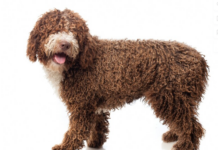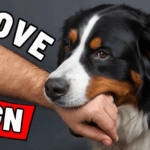Last Updated on April 25, 2022 by Dogs Vets
Finnish Lapphund: Information on the dog breed as well as an owner’s guide
The Finnish Lapphund is a purebred herding dog that originated in Finland and is medium in size. Finnish Lapphunds are also referred to as lappies in the United States.
These dogs are extremely friendly and get along with all members of the family as well as other pets in the house.
This breed, on the other hand, craves attention and requires an owner or a family who is willing to interact with and play with it on a regular basis.
Lapphunds from Finland are typically priced between $1,000 and $2,500 USD.
What exactly is a Finnish Lapphund dog?
This unique breed of herding dog was named after the indigenous, nomadic Lap (also known as Sami) people of Lapland, who were the inspiration for the creation of the breed.
Lapland is a remote region north of the Arctic Circle that includes parts of Sweden, Finland, and Norway. It is also known as the “Land of the Midnight Sun.”

These affectionate dogs, sometimes referred to as “Lappies,” are well-known for their friendly personalities, loyalty, their strength, and agility, as well as their overall intelligence. Both with children and with senior citizens, they are excellent.
Finland’s Lapphunds descended from ancient breeds of Spitze dogs, which were originally used for reindeer hunting before being domesticated.
Because of the changing nature of Lap society, the role of this breed gradually evolved from that of a hunting dog to that of a reindeer herding companion.
The use of herding dogs for reindeer has decreased significantly in recent years as a result of modernization. Although they are no longer used to herding reindeer, there are still some isolated areas where they are.
Experts estimate that there are still several hundred thousand reindeer in rural areas that are being herded by Finnish Lapphunds today, according to their estimates.
Our popular image of reindeer is sometimes distorted by cultural images and portrayals, such as the classic Christmas depiction of reindeer pulling Santa’s sleigh, which can be misleading. The reality, however, is quite different.
Reindeer are extremely aggressive and potentially dangerous animals to be around. Their antlers are capable of causing lethal injury to humans and other animals.
The strength, agility, and courage of the Finnish Lapphund were all excellent characteristics for interacting with reindeer, whether in their historical roles as hunters or later in their transition to the role of herding dogs.
When herding reindeer, they are well-known for their unusual, high-pitched bark (which has been compared to a squawk-like sound in some cases).
The well-known “startle reflex” of the breed has traditionally been associated with their roles as reindeer herders.
Finland’s Lapphunds have historically been tasked with responding quickly to sudden and potentially dangerous movements from potentially dangerous reindeer.
However, despite this reflex, which can still be observed in the breed today, they are known to recover quickly from the effects of the initial reflex.
They are friendly, loyal, courageous, and agile, and they are generally regarded as being submissive to other people’s wishes and desires.
Lappies have become increasingly popular as pets in recent years, particularly in the colder climates from which they originate.
They are less well-known in other countries, but that is slowly changing as more people become aware of the benefits of this affectionate breed.
Because they are a breed that originated in cold climates, they are ill-suited for climates that are hotter. This does not rule out the possibility of them surviving in warmer climates, however.
In Australia, this breed has gained in popularity. It is true that this is a less than ideal environment.
Despite the fact that this is a breed that was bred to tolerate and perform well in cold outdoor temperatures, it must be kept indoors with you at all times. It is a very sociable animal that requires to be included in the household.

Despite their friendly demeanor, they have a tendency to bark when they encounter something unfamiliar.
However, because of their overall friendly temperament, they are unsuitable to serve as guard dogs due to their ability to be effective watchdogs.
When this breed becomes bored, it is common for them to resort to excessive barking.
Finnish Lapphunds are medium-sized dogs with thick, long-haired double coats that are a favorite of hunters.
The coat provides them with the ability to withstand extremely cold weather while also providing resistance to water. They are capable of adjusting to a variety of living situations. They are large, powerful, and agile animals.
Lappies necessitate a great deal of attention. Due to the breed’s easygoing and intelligent nature, it is a good choice for first-time dog owners, provided that these owners interact with their pets. They have a life expectancy of 12-15 years if given proper care.
They do exceptionally well in herding trials, obedience trials, and other agility-related skills competitions.
A period of time following World War II was marked by widespread distemper, which threatened the survival of the breed. Breeders, to their credit, took aggressive measures to save the breed, and they were ultimately successful.
The Finnish Lapphund was first recognized by “The Finnish Kennel Club” in 1945 under the name “The Lappish Herder,” and was later renamed to “The Finnish Lapphund.” The name of the dog was officially changed to the Finnish Lapphund in 1993, and it has remained in use ever since.
The American Kennel Club officially recognized them as the 171st breed in 2011, making them the club’s 171st official recognition.
Finnish Lapphund Appearance

His coat is thick, and his build is strong. He has a broad muzzle and is of medium size. Ears that are small to medium in size and triangular in shape, and that are spaced reasonably widely apart on the head.
Here are 7 compelling reasons why you should get a Finnish Lapphund!
#1. They’re absolutely stunning canines. Despite the fact that their voluminous coat gives them the appearance of being larger, Finnish Lapphunds are actually medium-sized dogs, with males standing an average of 18-21 inches tall and females standing an average of 16-19 inches tall.
They have a straight or wavy coat with a soft dense undercoat that is both dense and soft. They also have a sweet, soft expression that is sure to win over hearts and melt hearts everywhere they go.
#2. This is a very old breed of dog. The Sami, a semi-nomadic people who lived in Lapland, which encompassed parts of Finland, Sweden, and Russia, were the ancestors of the Finnish Lapphund.
Remains of Lapponian dogs have been discovered dating back to 7000 B.C.! The dogs were used to herd reindeer as the Sami culture evolved into a less nomadic one as the people became less nomadic.
#3. Speaking of reindeer, these are tough animals with dangerously sharp hooves that can cause serious injury or death.
Although herding sheep or cows necessitates the acquisition of specific skills, herding reindeer necessitates the acquisition of additional skills that are inherent in Lappies.
The breed is quick, brave, and agile, and they have a strong startle reflex, which came in handy if a herd of reindeer suddenly turned against them.
#4. Another important characteristic of this herding dog is its proclivity to bark.
Finnish Lapphunds used to bark in order to keep the herd under control, and they still do so today.
On the one hand, this makes them excellent watchdogs, as they will alert you if someone is approaching.
On the other hand, teaching your Lappie when it is acceptable to bark and when it is not is an important part of the training process for him.
#5. The Finnish Lapphund is sometimes referred to as a “thinking breed,” which refers to its ability to reason. Even though they are strong-willed, as is the case with most herders, Lappies respond well to training and perform well in dog sports such as agility and rally.
They also work well as tracking dogs, therapy dogs, and search and rescue dogs, among other things.
#6. The Lappie is not a guard dog in the traditional sense. He will make you aware of the presence of strangers, but he is not aggressive in any way. In reality, he is a loyal, sociable, and good-natured breed of dog.
#7. Despite his physical resemblance to the Australian Shepherd, Samoyed, and Siberian Husky, he is an entirely different breed.
The Finnish Lapphund is calm, friendly, and attached to his human pack, but he also possesses the intelligence, quickness, and courage of a dog who has been trained to work in harsh northern environments. It’s no surprise that the breed is becoming increasingly popular!
The weight and size of a Finnish Lapphund
This breed stands between 17 and 20 inches tall on average. Males typically weigh between 33 and 52 pounds, whereas females typically weigh between Finnish Lapphunds and 53 pounds.
Finnish Lapphunds Dog Colors
Finnish Lapphunds are available in a variety of colors, including white, grey, and red, among others. However, black is the color that is most frequently encountered in this breed.

Finnish Lapphunds Coat
Finnish Lapphunds have a thick double coat with long hair, which makes them look like huskies. The outer and inner coats of this dog enable it to withstand the harsh, frigid conditions of the arctic climate.
Their outer coat is made of a material that repels water. In addition, they have a proclivity to shed excessively, and they are not hypoallergenic. Dog hair will be everywhere, and owners will have to vacuum a lot. They shed between 1-2 times per year on average.
Personality and temperament are important factors to consider.
Dogs’ behavior in the presence of other dogs
These friendly dogs get along with other dogs and are very social. Being alone is uncomfortable for them because they are used to being part of a pack and being confined in close intimate quarters with humans.
How well does a Finnish Lapphund make a family dog in your home?
They make excellent companions. This amiable breed gets along well with both people and other dogs. They do, however, require attention and an owner who will engage in interaction and playtime with them.
They have a lot of shedding. When they become bored, they have a proclivity to destroy things and bark excessively.
In other words, if you are able to provide it with the attention it requires, it is an excellent dog for your family. Otherwise, he will become disinterested. He might even end up chewing your favorite shoes and barking at the mailman if you don’t keep an eye on him.
How to Raise and Train a Finnish Lapphund dog
Lapphunds from Finland are extremely intelligent and eager to learn. They are quick to pick up new skills. They can, however, be extremely obstinate.
As a “soft-breed,” they are regarded as a breed that is simple to train. The key is to design a training program that is appropriate for their needs while also maintaining their interest.
Dog sports and incentive systems are frequently beneficial. Despite the fact that dog treats have a place in dog training, pet owners should be aware that giving their dogs too many of these treats can lead to obesity and other weight problems.
Experts believe that it is best to begin training this breed when they are very young, rather than later in life. It is best to keep all training sessions brief and interesting in order to maintain their attention.
How To Care For a Finnish Lapphund
Exercise Requirements
Ensure that your dog gets at least 30-minutes of exercise per day, according to the recommendations of experts. In general, Lappies require moderate daily exercise, which can be provided by walks or by engaging in outdoor activities.
Many owners enjoy taking their dogs for a morning jog with them in the morning. They are not the best pets for people who live in apartments with limited space.
Haircuts, Grooming, and Shedding
At the very least, Finnish Lapphunds require combing once or twice a week. Hair should be trimmed with care in areas that are prone to matting so that the dog does not become matted. They are well-known for shedding a lot.
When they are shedding, they should be combed on a daily basis. Generally speaking, shedding occurs once or twice a year.
Additionally, their nails must be trimmed and their teeth must be brushed on a regular basis.
Dogs’ nails should be kept trimmed at all times. It can be extremely painful for them, and it can limit their mobility as well.
Finnish Lapphund Diet or Food
Finnish Lapphunds require high-quality dog food that is rich in essential nutrients, but they do not require a special diet designed specifically for this breed. Typically, two cups of dry dog food per day is sufficient.
Treats on an as-needed basis are acceptable. However, it is critical that the amount of treats provided remains within reasonable limits.
Overindulging in sweets can result in obesity and other weight-related problems.
Additionally, as with all dogs, they require access to fresh, clean water on a consistent basis. Water sources should be easily accessible to the general public.
It is generally recommended that you do not feed any dog human food. The use of occasional table scraps is recommended by some experts, but this should be discussed with a knowledgeable veterinarian before being implemented. It is, without a doubt, not ideal and should only be done on rare occasions.
While it is understandably tempting for pet owners to feed their animals, there is no way to minimize the negative consequences for their health. It’s not very healthy for them, to put it mildly. Furthermore, it is simple to develop bad eating habits.
Finnish Lapphund Dog Breed Health Issues

Lapphunds from Finland are generally regarded as a very healthy breed of dog. However, just like other dogs, they have their own unique set of predispositions and susceptibilities to a variety of health conditions.
Progressive Retinal Atrophy, a form of retinal atrophy (PRA), Canine Multifocal Retinopathy, which can cause decay of the retina (CMR3), Glycogen Storage Disease, elbow, and hip dysplasia, and cataracts are some of the potential health issues associated with this breed.
Progressive Retinal Atrophy (PRA) is a degenerative disease that affects the photoreceptors in the retina, and it has the potential to cause permanent blindness.
Generally speaking, it can take anywhere from 1-2 years from the time of the initial onset of this disease until the time of eventual blindness.
Unfortunately, there is no current treatment available for PRA at this time.
Canine Multifocal Retinopathy (CMR3): Fortunately, and in contrast to the effects of the more insidious PRA, this degenerative disease does not result in total blindness in the affected dog.
The slow progression of this disease results in circular areas of degenerative detachment that become filled with fluid as the disease progresses.
Blisters of various colors, including tan, gray, and pink, develop as a result of the fluid buildup. On rare occasions, these blisters will eventually heal on their own accord.
They may reappear after a period of healing. There is documented evidence of vision loss as a result of this.
Glycogen Storage Disease:
This disease is characterized by the accumulation of excessive carbohydrate levels in the body’s tissue. The condition manifests itself initially in a neurological manner. The disease is, unfortunately, a terminal one.
Finnish Lapphund and Water
Take this breed of dog to the beach for a day of swimming, and you will not be disappointed. Despite the fact that they are not commonly referred to as water dogs, you can find conflicting anecdotal evidence online from owners about their dog’s approach to water.
Some owners report that their dogs are averse to even getting their paws wet in the first place. Several people have reported that their pets actually enjoy going in (and even wading!) in the water when the weather is hot.
Generally speaking, this is not a breed that is particularly fond of water. Regardless, your Finnish Lapphund’s temperament will most likely play a role in how well he or she copes with the water.
Buyer’s Guide
How to choose the Right Finnish Lapphund Puppy for Your Family
When you’ve finally made the decision to own a Finnish Lapphund, the next step is to select the most suitable puppy for your family. What is the most effective method of selecting a puppy?
Throw out that sage advice you’ve been given about picking the first person who comes up to you.
However, the problem is that all of the other dogs in the litter will be forgotten about as a result of this decision.
According to experts, it is best to first observe the entire puppy litter as a group before making any decisions.
Instead of only observing and evaluating the most excitable puppies who approach you first, the more hesitant puppies will also be observed and evaluated in this manner.
Following the observation of the litter, each individual puppy should be evaluated when he is separated from the rest of the litter. This is an excellent method of observing the dog’s overall behavior in a variety of settings.
All conscientious prospective owners should examine the puppy for any physical abnormalities, including:
- Carefully observe the animal’s coat. Consider the following questions: Is it clean and healthy?
- Are there any bald patches or patches of hair loss on your head?
- There are abrasions or inflammations on the dog’s skin, should this be the case
- Is the puppy able to walk with ease?
- Is there any evidence of a problem with your walking gait?
Is there no infection, swelling, discoloration, inflammation, redness, discharge, or other abnormalities on the mucous membranes or in other areas?
Have you checked to see if the puppy’s groin and surrounding area are normal? Inflammation should be absent throughout the entire region.
Breeders Should Be Asked the Following Questions
There isn’t a definitive list of questions to ask a professional breeder that covers all possible scenarios. The following are the types of questions that you should absolutely ask during your interview.
A reputable breeder will always be able to provide you with all necessary information and documentation, including:
- Can you tell me about the dog’s vaccinations?
- Exactly which vaccinations are still needed?
What are all of the medical details and issues that I need to be aware of in regards to this particular dog? - What medical records do you have for me that pertain to the dog’s past medical history?
What is your company’s policy if my dog develops serious genetic problems later in life as a result of his breeding? - Are the puppies in your care registered with the government?
- If so, with which organization do they have a formal affiliation?
- I’m wondering how long it will be before I can take my puppy home with me.
- Is it possible for me to pay a visit to the facility where the puppies were raised?
- Is it possible for me to interact with and observe the entire puppy litter?
- Is it possible for me to meet the puppy’s parents?
- What is the medical history of the dog’s family?
- How long have you been involved in the breeding industry?
- Are you a member of a nationally recognized breed club? If so, which club do you consider yourself a member of?
- Please provide me with any professional references that you may have.
Red Flags
In your search for a responsible breeder, there are certain things you need to watch out for. The following red flags are important signs that you should recognize which will indicate that you aren’t dealing with a responsible breeder or a professional breeding facility:
- You should be concerned if the breeder does not have any professional references to show you.
- You should also be concerned if they are unable to provide you with the proper documentation for the dog, whether medical or registration.
- A seriously responsible breeder will always ask you to sign a contract.
- A good breeder will not bargain with you over the price. This isn’t a bazaar.
- If they are selling the dog for considerably less than it would normally cost, you should be concerned.
- If the dog appears dirty or disheveled, unhealthy, or neglected, you should be very concerned.
- If the breeding facility is dirty you are dealing with a shady business. A proper breeding facility must be clean and hygienic to meet all proper breeding standards.
- The breeder doesn’t ask you any questions. This is the sign of an unprofessional or negligent breeder.
- A good breeder will grill you with important questions to determine if you are likely to be a good dog owner. He will want to find a loving home for his puppy, and he cannot do this if he can’t determine if you would make a responsible owner.
- If they neglect this critical step, it proves that they are more interested in the sale than in the puppy’s welfare.
What Does a Finnish Lapphund Cost in Today’s Market?
What is your financial situation? From the outset, you should be aware that, as is the case with purebreds, they can be extremely expensive to keep and care for on your property.
Finnish Lapphunds can be purchased from professional breeders for a price ranging from $1000-$2500.
Breeders and purebreds can occasionally be found at animal shelters in the local area. If they are available, Finnish Lapphunds will almost certainly be significantly less expensive than those purchased from a breeder.
An animal shelter will charge you approximately $300 to cover the costs of caring for your puppy before he is placed for adoption. The precise amount will depend on the individual shelter.
In addition to the purchase price, prospective dog owners should factor in the overall costs of feeding their dog throughout the various stages of his life, as well as the costs of veterinarian visits, exams, vaccinations, as well as the costs of periodic grooming. Prices will fluctuate as your dog progresses through the various stages of its development.
Finnish Lapphund Vs Finnish Spitz

Pros & Cons of a Finnish Lapphund
| Pros | Cons |
| Intelligent, loyal, friendly, agile, and courageous are just a few of the characteristics that define him. | Finnish Lapphunds can easily get bored. |
| They are generally submissive (but not shy) to humans. | They necessitate a great deal of interaction and attention from their owners. They are not recommended for those who are unable or unwilling to devote the necessary time and attention to their animals. |
| As a “soft-breed” they are considered an easy breed to train. | They may bark when they encounter unfamiliar people or when they become bored. |
| Get along well with children. | Shed their hair copiously. |
| Have a long lifespan and can live from 12-14 years. | They are Not hypoallergenic breeds. |
| Get along well with other dogs. | They are susceptible to a number of medical conditions, as are many other breeds, which owners should be aware of before getting one. |
| The breed was developed to withstand the extremes of outdoor cold temperatures. |
Finnish Lapphunds Summary
So in conclusion, what can we say about Finnish Lapphunds?
They are friendly, loyal, intelligent, and courageous. They are strong and agile and they make excellent family pets.
Lappies are excellent for children and the elderly. Many experts maintain that they are also ideal for first-time owners, provided that their owners are willing to give them proper attention.
Finnish Lapphunds enjoy the companionship of people and other dogs. It is essential that they get the attention and human interaction that they need. When they are bored, they are prone to engage in excessive barking.
While proper training can do much to limit and curtail this behavior, it will never be entirely eliminated.
They are medium-sized dogs with thick double-coats of long hair. They shed heavily one or two times a year, and require periodic grooming which should include maintenance of nails and their teeth.
As a breed that originated in extremely cold climates, this isn’t an ideal dog for those owners living in warmer regions. Nevertheless, they are capable of living in such climates. The growing popularity of this breed today in Australia is proof of this.
In such less than optimal environments, owners will have to ensure that their pets have easy access to the indoors where there should be suitable air conditioning or other climate control technology to accommodate their physical needs and help them cool down.
Finnish Lapphunds are considered a healthy breed. As with most dogs, they are susceptible to several different health conditions.
Some of the problems associated with this breed include Progressive Retinal Atrophy, a degenerative form of retinal atrophy (PRA), Canine Multifocal Retinopathy, causing retinal decay (CMR3), Glycogen Storage Disease, elbow, and hip dysplasia, and cataracts.
With the proper regimen of daily exercise, a diet rich in essential nutrients and minerals, and frequent medical care, Finnish Lapphunds can live a long time. Under optimal conditions, they can live anywhere from 12-14 years.
We have tried to provide you with all the relevant information you need to help you decide if this is the right breed for you.
We have included all pertinent information regarding their general temperament, characteristics, health issues, and overall costs.
Is the Finnish Lapphund the correct breed for you? There is certainly a lot to love about this playful and loving breed.
They are very easy to train and they have great temperaments. They love people and are friendly with other dogs.
The question ultimately boils down to this: Are you, the prospective owner willing to provide this sociable dog with the necessary attention it requires? If the answer is yes, then the answer is a simple one. This is indeed an excellent pet to own. Under such conditions, we highly recommend the Finnish Lapphund as a pet.
Facts Check
We hope you enjoyed this article… What are your thoughts?
Рleаse feel free to share with us in the comments section below!
![Finnish Lapphund dog breed Information: Ultimate Guide [13 Facts] Finnish Lapphund dog breed Information: Ultimate Guide [13 Facts]](https://dogsvets.com/wp-content/uploads/2022/04/Screenshot-2022-04-22-at-2.24.58-PM-696x389.png)
















